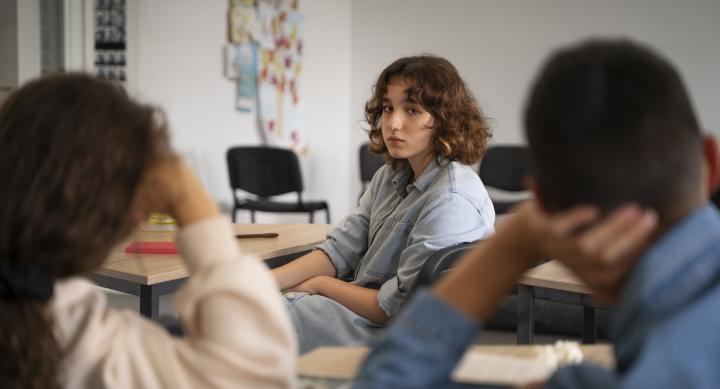
Safety Planning with Parents of Students That Express Suicidality
March 2023
For the Deep Dive for March 2023, our client champion was Kathleen Casey, Ph.D. Dr. Casey is the Senior Director of Clinical Innovation at Integral Care here in Austin. Integral Care works with Travis County leaders in public health and mental health on the children's mental health crisis, especially following the pandemic.
Background
Austin Integral Care has a program to provide mental health services in Travis County schools. When the therapist determines that a student is at an elevated risk of self-harm, they call the student's parents to discuss a plan of care. This plan is individualized to the needs of the student based on their clinically evaluated risk.
The recommendations from the therapists generally fall into one of two categories:
- The student should be picked up and taken directly to the emergency department to be screened for a possible intake into a higher level of care.
- Safety planning with the student and their family.
Stacey notes that 80% of cases are resolved with safety planning and starting outpatient services. With safety planning, the goal is to do the initial safety planning work over the phone, and then have staff follow up with the student and family the next day.
There are some areas where the current process could improve:
- The conversation with parents can be quite challenging, and many times exceeds 60 minutes as the therapist shares heaps of validation and education to get the parent to agree to a plan. One of the foundational pieces of this conversation is that every outcry should be taken seriously.
- Parents can be resistant to participating in a plan when the child has been frequently hospitalized. Some parents will respond that their child is being dramatic, while others may be overwhelmed with the other responsibilities of life.
- With the recommendation of an ED visit, Stacey shares that parents ask, "If I take my kid to the hospital, what will happen?", "What is this going to cost me?", "Can they hospitalize my child for the day or more?"
- In many cases, the school policy requires the student to be picked up regardless of how a parent feels about the severity of the suicide risk. This places an added burden on the parents who must leave work or make other arrangements to come and pick up their child.
This Deep Dive discussion aimed to strategize communication strategies to support the therapists in this work.
Highlights from the Think Tank Discussion
Tactics for Supporting Therapists: How to Enjoy This Work
Takeaways | Recommendations | Implementation/Examples |
|---|---|---|
These are difficult discussions | Validate the challenge | Acknowledge the many barriers to a parent/guardian having these discussions |
High turnover of therapists | Acknowledge any lack of training and experience | Training: Role playing exercises Provide set-ups and debriefs |
Build Trust
Takeaways | Recommendations | Implementation/Examples |
|---|---|---|
Set up the conversation | In terms of quantity and quality Prepare yourself; prepare the parent/guardian | "I want to spend the next 20 minutes talking about insert shared goals." Reach agreement on timing and setting. |
Take the parent/guardian's perspective | Consider the worst things the parent/guardian might think. Say those things out loud. | "You may think I don't know you and I don't know your child, but this is what I am trying to prevent, and this is what I want to accomplish." |
Motivational interviewing | Affirmation | "You probably know your child better than anyone" "Some people have noticed...(red flags)..." |
Honor parent/guardian expertise/opinion | Approach the work with humility and curiosity | After the conversation ask what worked and what might be done differently the next time. |
Anticipate and Pre-empt Shame and Defensiveness
Takeaways | Recommendations | Implementation/Examples |
|---|---|---|
Commiserate | Parenting is difficult | Name the difficulty |
Be curious | Data gathering mode | "I'm gathering information as much as giving information here." "What have you noticed?" "What would it look like if...your child is eating dinner with you...what would they say about their day?" |
Importance and Immediacy: We Can Always Pull Back Later, but We Can't Walk Suicide Back
Takeaways | Recommendations | Implementation/Examples |
|---|---|---|
Exaggeration as a tactic | Interpret it as "I don't feel heard and understood" | Help the parent/guardian make this a priority |
"This could never be my child" | Moving toward: "This is something that could affect my child" | Engage parents with best-case/worst-case scenarios Offer facts/statistics "Here are some things many parents didn't notice until someone brought it up" |
Identify and Acknowledge the Burdens and the Barriers
Takeaways | Recommendations | Implementation/Examples |
|---|---|---|
The work of reflecting on their relationships with their children | Name the barriers Discover which are relevant | "What are the barriers that keep you from addressing this right now?" |
False belief that children are resilient and immune to long term harm | ||
Cultural variation in conceptualization of mental health | ||
Immigrant status Language barriers Economic pressures Work obligations Transportation Insurance |
Provide Support and Resources for the Parent/Guardian
Takeaways | Recommendations | Implementation/Examples |
|---|---|---|
Feeling of isolation | Support network | Talk with parents who have lost a child to suicide Talk with parents who have a child undergoing SI prevention |

